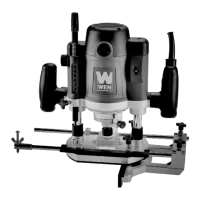ASSEMBLY AND ADJUSTMENT
Material
Bit Diameter (inches)
Feed Rate
≤1/2 3/4 1 1-1/4 ≥1-1/2
Router Speed Setting
Pine 5-max 5-6 4-6 3-5 3-5 Fast
Oak 5-max 4-6 4-5 3-5 2-4 Moderate
Cherry 3-5 3-5 3-4 2-4 2-3 Moderate
Maple 3-5 3-5 3-4 2-4 2-3 Slow
Particleboard and MDF 5-max 5-max 4-max 3-5 3-5 Fast
Soft Plastics 3-5 3-5 3-4 2-4 1-3 Slow
Hard Plastics 2-4 1-4 1-3 1-2 1-2 Slow
Aluminum 3-4 3-4 2-3 2-3 1-3 Slow
SETTING THE ROUTER SPEED
The router is equipped with a variable speed dial (Fig. 13) that can control the
bit rotation speed from 8,000 - 23,000 RPM. If the router speed is too high,
friction will generate excessive heat and scorch the workpiece. If the router
speed is too low, the bit will tear the material and result in rough or uneven cuts.
The optimal rotation speed of a particular router bit varies, depending on bit’s
diameter, the material being cut, the cutting depth, and the cut’s style.
In general, the larger the bit's diameter, the slower you should set the router
RATE OF FEED
The rate at which the router is moved through the material also has a significant effect on the quality of the cut and
the lifetime of your router and bits. Moving the router through the cut too fast or overloading the tool will cause the
bit to take larger pieces of material with each rotation, resulting in a rough, uneven cut. Moving the router through
the workpiece too slowly tends to scorch the workpiece and possibly overheat the bit.
The proper feed rate to use depends on the bit size, the material being cut, the depth of cut and the speed selected.
Use the chart below (Fig. 15 - Router Speed and Feed Rate Settings Chart) as a reference for how fast your router
should be moved along the workpiece. The best way to ensure that you get a quality cut is to practice on a scrap
piece of the same material to get a feel for what feed rate to use. This will also show you exactly how the cut will look
and allow you to check your cutting depth.
Fig. 13
Fig. 14 - Router Speed and Feed Rate Settings Chart
CAUTION: The fan does not cool the motor effectively at lower speeds and may cause the motor to overheat. Do
not run the tool at low speeds for extended periods. Occasionally run the router at high speed with no load to allow
the motor to cool down.
speed. This is because larger bits have a greater tendency to generate vibration at high speeds. Refer to the instruc-
tions and maximum speed specified by the manufacturer of your router bit. You can also use the chart below (Fig.
15 - Router Speed and Feed Rate Settings Chart) as a rough reference for setting the router speed. To best deter-
mine the router speed, test the speed on a scrap piece of the same material. This will allow you to see the cut result
and make adjustments before working on the actual workpiece.
12

